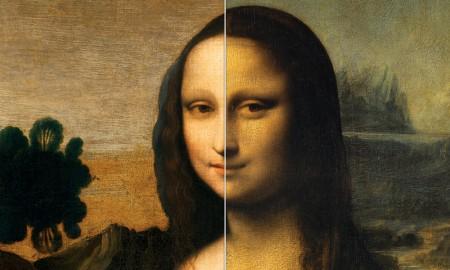Scientific tests conducted by a Swiss art foundation reveal that a painting of the ‘Mona Lisa’ unveiled last year is possibly an early version of Leonard Da Vinci’s iconic masterpiece in the Louvre.
Called the ‘Isleworth Mona Lisa’, the canvas in Switzerland is of the same subject as the Leonardo painting in the Louvre in Paris. In 1913, an English art collector, Hugh Blaker, discovered the painting in the Somerset home of a nobleman whose family acquired the painting c. 1730–50. Blaker bought the painting and took it to his studio in Isleworth, London. His discovery, combined with historical accounts, point to the likelihood that Leonardo painted two distinct and different portraits of Lisa del Giocondo: the one in the Louvre and the one discovered by Blaker.
In 1914, the ‘Isleworth Mona Lisa’ painting was sent to the USA for safekeeping during World War I, where it was housed in the Boston Museum of Fine Arts until 1918. In 1962, Blaker sold the painting to American collector Henry F. Pulitzer, who took the painting to Switzerland and stored it in the vaults of a bank in Lausanne. After Pulitzer and his wife both died, the ownership of the painting passed to an international consortium in 2008. Two years later, The Mona Lisa Foundation, a non-profit foundation, was established in Switzerland to research and exhibit the painting, and it has gathered historical evidence regarding the painting’s provenance.
The Mona Lisa Foundation announced the results of tests conducted on the painting by an Italian specialist in the geometry of Leonardo, Alfonso Rubino. He presented his latest findings that show that Leonardo worked the geometry found in his design of the ‘Vitruvian Man’ (1487) into his paintings. According to Rubino, the ‘Isleworth Mona Lisa’ portrait embodies the intermediate stage of Leonardo’s geometric constructions and must be by Leonardo.
The Mona Lisa Foundation president, Dr. Markus Frey, said: “The results of these further tests are very convincing. They confirm our conclusion that this painting is indeed Leonardo’s ‘Earlier Version’ of his ‘Mona Lisa’.”
In addition, some skeptics had assumed that the painting was a work of the 17th century but a new carbon-14 dating test provides a narrower dating window than previous results obtained at Oxford University. It establishes the date of the canvas to be between 1410 and 1455 and makes such suggestions improbable.
The latest carbon-dating test on the canvas of the ‘Isleworth Mona Lisa’ was performed by the Eidgenössische Technische Hochschule (Swiss Federal Institute of Technology) in Zurich and confirms a dating between 1410 and 1455 (95.4% probability), and more precisely within that time range between 1425 and 1450 (68.2% probability). Consequently, the foundation says it is highly unlikely that the ‘Isleworth Mona Lisa’ would have been executed beyond the turn of the 16th century; the first documentary evidence of Leonardo painting the ‘Mona Lisa’ is the eyewitness account of Agostino Vespucci in 1503.
Previously, four tests undertaken by nuclear physicist Professor John Asmus, who digitised the brushstrokes of both paintings, established scientifically that both the ‘Isleworth Mona Lisa’ and the ‘Mona Lisa’ in the Louvre would have been executed by the same artist. The brushstroke analysis identifies an artist in the same way that DNA or fingerprints identify criminals.
The ‘Isleworth Mona Lisa’ is wider than the ‘Mona Lisa’ in the Louvre, having columns on either side. The Louvre painting has the projecting bases of columns on either side. It is possible that the portrait in the Louvre derives from the ‘Isleworth Mona Lisa’ with Leonardo adding a more complex background and leaving out the side columns. The figure of the ‘Isleworth Mona Lisa’ resembles that of the ‘Mona Lisa’, and is identically composed and lit. However, the face of the ‘Isleworth Mona Lisa’ appears younger, causing speculation that it is an earlier version by the artist. The background in the ‘Isleworth Mona Lisa’ painting is less detailed than that in the Louvre’s ‘Mona Lisa’.
“When we add these new findings to the wealth of scientific and physical examination results published in our recent book ‘Mona Lisa - Leonardo’s Earlier Version’, I believe anyone will find the evidence of a Leonardo attribution overwhelming,” said David Feldman, vice president of The Mona Lisa Foundation.









